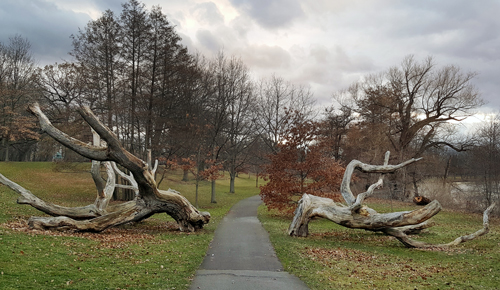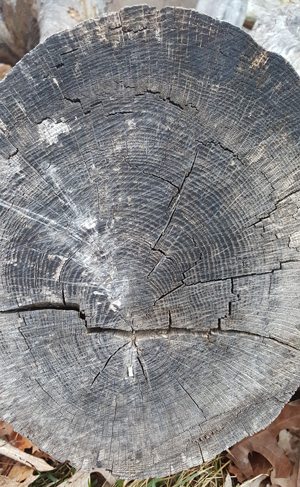story and photos by John Ernst

As it stood in February of 2016.
One summer during college, I worked as a landscaper at Genesee Valley Park. I savored the chance to work outside. Each day I would drive my Gator through the misty sunrise at 5 a.m., surveying the park and ensuring that all was well before hikers and picnickers arrived. And each day, I marveled at the mighty branches lying on either side of the trail. It was a bitch to mow and weed whack, so other employees let the grass grow, giving it a wild and unkempt appearance. A few weeks into my job I learned it was called the “tree of life,” and that it had been struck by lightning, breaking it in half, years before. Feeling an odd sense of connection with the tree, I started taking better care of it.
Years later, my attempt at research on the tree has borne little fruit. Its only online remembrance seem to be a photo gallery on the University of Rochester’s website commemorating the tree’s life, and a memorial page on Facebook. I learned that it was struck by lightning on July 4, 2010 and before it fell, it looked like a pair of hands opening to the sky. I also learned how genuinely Rochesterians loved it. Both the photo gallery and memorial page highlighted that.
For more information I called the Monroe County Parks office, which referred me to Chris Kirchmaier, Supervisor at Highland Park. He told me that he was actually on the forestry crew that cut down the tree the day after it was struck. “I’m not sure that there is a recorded history,” he said, “just a popular tree and a cool structure. Every day I drove by there were four, five, even ten people sitting in it or climbing it.” He told me that he’s only 36, and that his older co-worker Joe Bernal, the tree crew supervisor, might have more answers for me.
“Well, it’s a white oak,” Bernal told me when I asked what he knew about the tree. “It had a perfect crotch, probably eight or ten feet up in the air.” Frederick Law Olmsted designed Genesee Valley Park in the late nineteenth century, and Bernal figured the Tree of Life predated that. “That would make it over 150 years old, and that wouldn’t surprise me,” he said. Earlier in his career, Bernal removed tags from the trees Olmsted had planted, but didn’t remember the Tree of Life having one. He expressed similar fondness as Kirchmaier had for the fallen tree. “Even when it was busted in half, I tried to keep the character in both sides and moved it down to the path.” He said that he’d like to see the tree preserved: “White oak is a wood that lasts,” he said. “But if we really wanted it to last, we’d have to lift it off the ground, get the bark off, and maybe coat it with some preservative.” As Supervisor, Bernal doesn’t have the time to take on a project like that, but hopes somebody does—perhaps a group of volunteers or students from the U of R. “It’s something I’ve always wanted to do,” he said before signing off.

Tree rings
I decided to revisit the tree and count the rings myself. I had forgotten how huge it was; heaving it up and preserving it would be no minor task. I set to counting the rings on the stub of a lopped branch. Many were so close together that they were indistinguishable, and the cracks didn’t make it any easier to count. I deemed it impossible to record any sound empirical data using this method, but I counted over a hundred rings. Maybe Genesee Valley Park’s ancient oak has no recountable history, but the Tree of Life has earned its nickname.
John Ernst is a passionate writer, hiker, and video gamer born and raised in Rochester. He is currently developing his website, nerdofearth.com.
Views: 5




